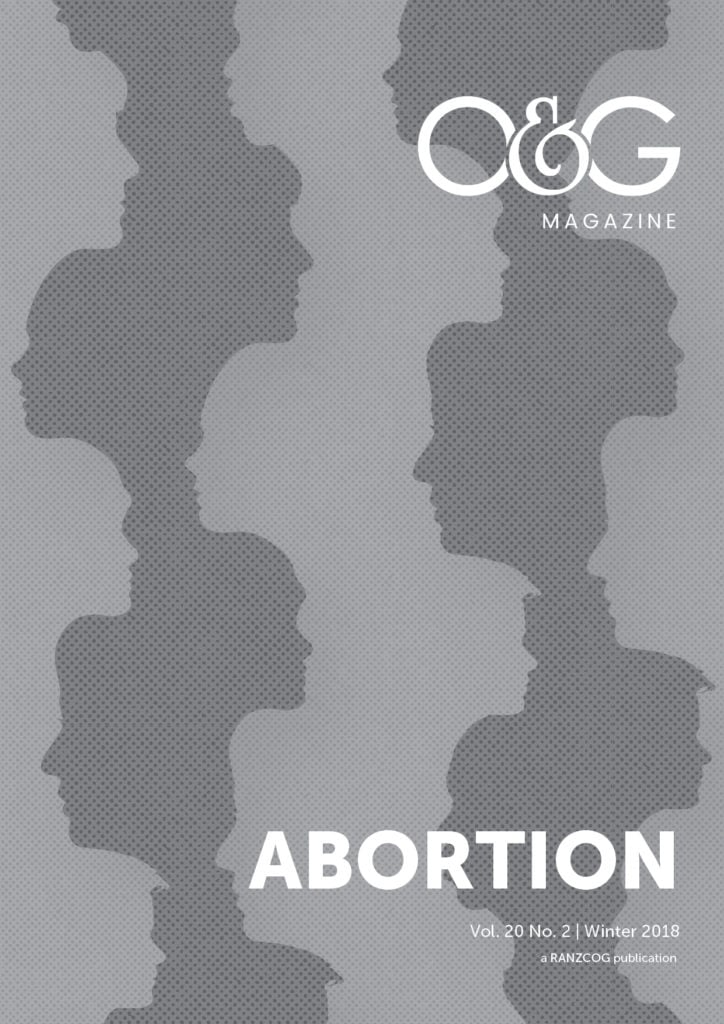An estimated 68,000 women die globally each year from the consequences of unsafe abortion.1 Complications of unsafe abortion are among the top five causes of direct maternal mortality.2 In Australia, an estimated 80,000 abortions are performed annually3 of which 95 per cent are done in the first trimester.4 There are currently no national data on abortions and differences in legislation across the Australian states and territories complicate this picture. The World Health Organization (WHO) estimates that 92.3 per cent of abortions performed in Australia are done safely, compared to the Oceania regional estimate of 66.3 per cent.5 There are still reports of women in rural and remote areas attempting unsafe abortion due to a lack of access to services.6
Mifepristone, as a safe medical abortion agent, has been licensed for use in Australia since 2012 and was added to the Pharmaceutical Benefits Scheme (PBS) in 2013.7 When used for early abortion, mifepristone and misoprostol have a success rate of 95 per cent.8 In 2005, this combination was added to the WHO Model Lists of Essential Medicines.9 Despite the proven efficacy, safety record and WHO endorsement of this method, there are still access barriers to medical abortion in Australia. These service gaps have started to be addressed through ‘telemedicine abortion’, the provision of medical termination agents via internet sites and phone services. This article aims to outline the main issues around the unrestricted online availability of abortion medicines.
Medical community issues and concerns
A major concern of the medical profession around unrestricted access to abortion medications has been the lack of pre-abortion care, including accurate dating of the pregnancy, with the potential for women to attempt termination at later gestations, leading to increased complication rates.10 The evidence suggests the reverse is true, and that online access allows women, particularly in rural and remote areas, to terminate at earlier gestations by removing the necessity to organise family and work obligations to make time to travel.11 Evidence suggests that using the last menstrual period (LMP) to date an early pregnancy is accurate and acceptable. WHO endorses abortion based on clinical assessment alone without ultrasound dating.12 However, WHO assumes that in the setting of global healthcare, many women live in areas without access to ultrasound. In Australia, ultrasound can rule out ectopic pregnancy and diagnose non-viability, removing the necessity of abortions for pregnancies that are destined to miscarry.
WHO states that ‘safe care includes community level healthcare providers trained in recognition of abortion complications to provide prompt referral for treatment, and transportation to services for management of complications of abortion’.13 WHO specify that ‘healthcare provider’ includes ‘any properly trained healthcare provider, including mid-level (non-physician) providers’. The provision of care by community nursing posts, with or without medical or midwifery input, might be considered by WHO to be safe. However, variances in training between midwives and nurses working in low-resource environments compared to high-income countries, and expectations of patients accessing care in Australia, need to be taken into consideration.
Post-abortion care is also a consideration, particularly in the event of a complication. The complication rate of early medical abortion is low. Aiken et al reported a success rate of 94.7 per cent (95% CI 93.1% to 96.0%) for women undergoing medical abortion at home via the ‘Women on Web’ (WoW) internet site.14 Of 1158 women, seven (0.7%, CI 0.3% to 1.5%) reported having a blood transfusion, and 26 (2.6%, CI 1.7% to 3.8%) required antibiotics. Ninety-three women (9.3%, CI 7.6% to 11.3%) reported experiencing a symptom for which they were advised to seek medical advice and, of these, 87 sought attention. None of the five women who did not seek medical attention reported an adverse outcome. Although this suggests that women are able to manage their own presentation to emergency medical care in the unlikely event of a complication, in Australia, there may be issues around patient access to appropriate emergency services in remote and rural areas.
Another concern regarding home medical abortion is the potential for harm to an ongoing pregnancy in the event of a patient changing her mind midway through the regime, or in the event of treatment failure. Women rarely change their minds after beginning a termination. In the US, less than 0.004 per cent of women taking mifepristone later chose to continue the pregnancy.15 In such a case, a woman should be counselled that there is a reasonable chance (10–45%) that the pregnancy will continue normally.16
A concern unique to the provision of medicines via online services is the veracity of the product. According to WHO, ‘the internet trade in medicines now represents a huge, unregulated (and perhaps unregulatable) market globally, which needs more research and attention’.17 More than 50 per cent of medicines purchased on the internet from illegal sites that conceal their physical address are counterfeit.18 The potential impact of this in general terms is enormous, including immediate risks, ‘failed’ treatment and a loss of confidence in medical services. However, the use of internet sites with a good safety profile and transparent auditing process, such as WoW or Marie Stopes, negates this concern as the medicines are prescribed by licensed medical practitioners.
Patient issues and concerns
Data from WoW has revealed that 49 per cent of women give barriers to access of services (including geographical distance, cost of travel, cost of childcare for existing children and long wait lists) as their reason for accessing online services. Thirty per cent of women have concerns regarding privacy and confidentiality (such as living in a small community and friends or family working in the local healthcare facility), and 18 per cent give fear of threat of partner violence or controlling family as their reason.19 Similar barriers exist in Australia, particularly in rural and remote settings.20 21 Access to services, concern regarding shame and stigma and financial barriers, including the costs of travel and accommodation, have been identified as issues in rural Australia.22 The cost of obtaining a private first trimester abortion ranges from AU$400 to $900,4 which can rise significantly when the cost of travel and accommodation is taken into account. This compares to the suggested donation of €90 (approximately NZ$155) for New Zealand users of the WoW telemedicine service, where women who are unable to afford this are subsidised by the site’s donation policy.23
There have been legal ramifications of patients obtaining abortion medicines online for use in Australia. In 2010, a couple were accused of obtaining mifepristone and misoprostol from an overseas source for use in a termination, in Queensland’s first ever case of a woman being charged with procuring her own abortion.24 The drugs were imported for personal use and there was no attempt to smuggle the drugs. Expert evidence was given that mifepristone is a safe medication for the woman, is listed as an essential medicine by WHO and is legally prescribed in Australia. The jury found the couple not guilty, as they were not satisfied that the combination of drugs constituted a noxious substance. The Queensland Criminal Code specifies that it is an offence for a woman to procure her own abortion by self-administering ‘any poison or other noxious thing’.25
In Australia, transparent pathways already exist for online access to abortion. Marie Stopes offer a telemedicine service to women over 16 years of age in Victoria, New South Wales, Queensland, Western Australia (patients require a GP referral), Northern Territory and Tasmania.26 Requirements include that the patient lives within two hours of 24-hour emergency medical care, speaks English, has internet access and is no more than eight weeks (56 days) pregnant at the time of the phone consult. The cost of this service starts at $290, excluding the cost of the medications.
Future directions
Access to safe and timely abortion and care are fundamental aspects of women’s reproductive rights and healthcare requirements. The introduction of telemedicine has been associated with a decrease in overall abortion rates in other areas.27 It is likely to be a safe and convenient option for women in areas of Australia and New Zealand with access to suitable emergency care in the rare event of complications. The provision of post-abortion advice, including contraception counselling is an essential adjunct to this service.
Despite the safety profile of first-trimester medical abortion and the growing body of evidence that abortion via telemedicine is used safely by the majority of women, concerns remain. Urgent work is needed at state and federal levels to ensure access to abortion services, resolve legal disparities between Australian states and territories, and to clarify the Australian legal position around abortion via telemedicine. As Petersen28 puts it, ‘There is no regulatory miracle which will stop the traffic of mifepristone and misoprostol, and therefore an intelligent regulatory response is required’.
References
- Grimes DA, Benson J, Singh S, et al. Unsafe abortion: the preventable pandemic. Lancet 2006;368(9550):1908-19.
- Perehudoff K, Pizzarossa LB, Stekelenburg J. Realising the right to sexual and reproductive health: access to essential medicines for medical abortion as a core obligation. BMC International Health and Human Rights 2018;18(8).
- Petersen K. Abortion laws and medical developments: A medico-legal anomaly in Queensland. Journal of Law in Medicine 2011;18:594-600.
- de Moel-Mandel C, Shelley JM. The legal and non-legal barriers to abortion access in Australia: a review of the evidence. Eur J Contraception Rep Health Care 2017;22(2):114-122.
- Ganatra B, Gerdts C, Rossier C, et al. Global, regional, and subregional classification of abortions by safety, 2010–14: estimates from a Bayesian hierarchical model. Lancet 2017; 390: 2372-81.
- de Moel-Mandel C, Shelley JM. The legal and non-legal barriers to abortion access in Australia: a review of the evidence. Eur J Contraception Rep Health Care 2017;22(2):114-122.
- de Moel-Mandel C, Shelley JM. The legal and non-legal barriers to abortion access in Australia: a review of the evidence. Eur J Contraception Rep Health Care 2017;22(2):114-122.
- Kulier R, Kapp N, Gülmezoglu AM, et al. Medical methods for first trimester abortion. Cochrane Database of Systematic Reviews 2011, Issue 11.
- Perehudoff K, Pizzarossa LB, Stekelenburg J. Realising the right to sexual and reproductive health: access to essential medicines for medical abortion as a core obligation. BMC International Health and Human Rights 2018;18(8).
- Grindlay K, Grossman D. Telemedicine provision of medical abortion in Alaska: through the provider’s lens. Journal of Telemedicine and Telecare 2017: 23(7):680-685.
- Grindlay K, Grossman D. Telemedicine provision of medical abortion in Alaska: through the provider’s lens. Journal of Telemedicine and Telecare 2017: 23(7):680-685.
- World Health Organization. Safe abortion: technical and policy guidance for health systems, 2nd edition. 2012 ISBN 978 92 4 154843 4.
- World Health Organization. Safe abortion: technical and policy guidance for health systems, 2nd edition. 2012 ISBN 978 92 4 154843 4.
- Aiken AR, Digol I, Trussell J, Gomperts R. Self-reported outcomes and adverse events after medical abortion through online telemedicine: population-based study in the Republic of Ireland and Northern Ireland. BMJ 2017;357:j2011.
- Grossman D, White K, Harris L, Reeves M. Continuing pregnancy after mifepristone and ‘reversal’ of first-trimester medical abortion: a systematic review. Contraception 92(2015) 206-211.
- Grossman D, White K, Harris L, Reeves M. Continuing pregnancy after mifepristone and ‘reversal’ of first-trimester medical abortion: a systematic review. Contraception 92(2015) 206-211.
- World Health Organization. A study on the public health and socioeconomic impact of substandard and falsified medical products. Geneva 2017. Licence: CC BY-NC-SA 3.0 IGO.
- World Health Organization. A study on the public health and socioeconomic impact of substandard and falsified medical products. Geneva 2017. Licence: CC BY-NC-SA 3.0 IGO.
- Aiken ARA, Guthriec KA, et al. Barriers to accessing abortion services and perspectives on using mifepristone and misoprostol at home in Great Britain. Contraception 2018;97:177-183.
- de Moel-Mandel C, Shelley JM. The legal and non-legal barriers to abortion access in Australia: a review of the evidence. Eur J Contraception Rep Health Care 2017;22(2):114-122.
- Doran FM, Hornibrook J. Barriers around access to abortion experienced by rural women in New South Wales. Journal of Rural and Remote Health 2016; 16:3538.
- Doran FM, Hornibrook J. Barriers around access to abortion experienced by rural women in New South Wales. Journal of Rural and Remote Health 2016; 16:3538.
- www.womenonweb.org/en/page/9254/donation-system. Accessed 12/04/18.
- Petersen K. Abortion laws and medical developments: A medico-legal anomaly in Queensland. Journal of Law in Medicine 2011;18:594-600.
- Petersen K. Abortion laws and medical developments: A medico-legal anomaly in Queensland. Journal of Law in Medicine 2011;18:594-600.
- www.mariestopes.org.au/abortion/home-abortion. Accessed 15/3/18.
- Grossman D, Grindlay K, et al. Changes in service delivery patterns after introduction of telemedicine provision of medical abortion in Iowa. American Journal of Public Health 2013;103:73-78.
- Petersen K. Abortion laws and medical developments: A medico-legal anomaly in Queensland. Journal of Law in Medicine 2011;18:594-600.








Easy to read and understand. Information about unwanted pregnancy was thoughtfully written.